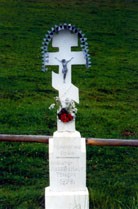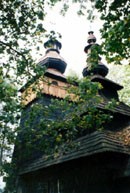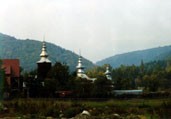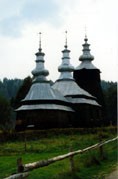 |
Vol 1, No 24
6 December 1999 |
|
|
 P O L A N D:
P O L A N D:
A Fractured Identity: The Lemko of Poland The Lemko are finding the reconstruction of their ethnic identity hindered by a variety of internal divisions. Karen M Laun Present-day Poland is perceived by many as being an ethnically homogenous country. To a great extent, this is true. However, there are still several significant minority groups residing within Poland’s borders - one of which is the Lemko. Now that Communism has come to an end, many minority groups are at last finding their voices once more and reviving their cultures in a new atmosphere of openness and freedom. The Lemko, a distinct ethnic group from the southeast corner of the country, are also attempting to reassert their cultural identity. However, they seem to be caught in a continuing identity crisis, as a result of which they are unable to unify themselves into one community and create a strong political organization that could effectively represent their interests. The northern slopes of the Carpathian Mountains in Poland (near the Ukrainian border) has been the Lemko’s home for centuries and this area is known to the locals as Lemkovyna, or Lemkowszczyzna in Polish. The Lemko belonged to the eastern branch of Christianity, used the Cyrillic alphabet and spoke an East Slavic language - yet they were neither Polish nor Ukrainian. The Lemko are sometimes considered to be Ruthenian or Rusyn, a term that indicates a pro-Russian orientation. Their attractive onion-domed wooden churches are still scattered throughout the remote and sparsely populated areas of the Beskid Sadecki, Beskid Niski and the Bieszczady mountains. Due to the inaccessibility of this region, the Lemko lived here relatively undisturbed by outside influences for many years.
In 1944, Poland and the Soviet Union agreed upon a series of population transfers that saw Ukrainians, Belorussians, Russians and Rusyns (Lemko) transferred to the Soviet Ukraine and Belorussia. Although these transfers were supposedly voluntary, there was strong pressure to move. Near the end of the war, the Ukrainian Insurgent Army (UPA) sent some of its members to fight in the Lemko region. Whilst few of the Lemko actually sympathized with the UPA, the new Polish People’s Republic did not see it that way. In Warsaw the Lemko were perceived as Ukrainian sympathizers. The result of this opinion was Operation Vistula (Akcja Wisla), the worst tragedy to befall the Lemko this century. In the spring and summer of 1947 the entire region was depopulated, whole villages emptied, as the Lemko were scattered throughout the northern and western territories of Poland. As they were moved out, Polish settlers moved into many of the abandoned villages and converted the Orthodox churches for Catholic use or left them empty. The theory was that exile would destroy support in the area for the Ukrainian nationalists. Instead, it nearly destroyed Lemko culture. Despite some stirrings of cultural activity after 1956, when some Lemkos were allowed to return to their homeland, the question of Lemko culture and identity was essentially frozen until 1989 and the fall of Communism. Along with the Kashubians, Roma, Germans and other Polish minorities, the Lemko have now begun to focus on preserving their unique culture and asserting their political rights. However, they have not re-emerged from this period as a unified group, old differences remain and new ones have arisen to make the reconstruction of their ethnic unity a difficult task. For all the Lemko their homeland has long been an important focus point of their cultural revival. While their mountain region was never autonomous, until 1947, it was always the geographic center of their identity. Thus the injustice of the deportations remains an important issue for many of the Lemko and the Polish government has yet to offer any reparations. However, the post-1947 Lemko community has grown up surrounded by Polish influences and individuals have often hidden their ethnic background to avoid ridicule. As a result, many are now largely assimilated into Polish society and disinclined to return to a rural farming lifestyle. The homeland still exerts a strong pull on many Lemkos, but often as more of an ancestral myth or a place of pilgrimage than as a place to reside. The feelings of community and identity provided by living in one geographic region have been dissipated, leaving them more open to further assimilation into the larger Polish community. Aside from the issue of assimilation, there are also major splits within the Lemko community, which pose difficult barriers to rebuilding a strong ethnic identity. The most contentious issue dividing the Lemko is that of religion, one of the main tenets of their identity. This conflict is not new; when Ukrainian nationalists were pressuring the Lemko to identify with their struggle and with their religion, during the early part of this century, there occurred a parallel backlash which led other Lemko to return to Orthodoxy. During the Communist era, this conflict was submerged due to the liquidation of the Ukrainian Greek Catholic Church, but it has now returned in the post-Communist era. Closely related to this division is one of ethno-national orientation. A recent census of minorities in Poland stated that there are between 50,000 and 150,000 Lemkos in the country. The huge disparity between theses two figures can be at least be partly explained by the fact that many of the Lemko, who are loyal to the Ukrainian Greek Catholic Church, are also pro-Ukrainian and identify themselves with the larger Ukrainian community. In contrast, the Orthodox members of Lemko society usually see their identity as being part of a larger Slavonic or Carpatho-Rusyn group and state their ethnicity as Lemko or Rusyn. These major divisions within Lemko society are not ameliorated by the attitude of the Polish government. While the government’s record of minority rights protection has generally been good, with ample provisions made for preservation of minority languages and traditions, the Lemko are officially considered to be part of the Ukrainian nation. This is problematic for the Orthodox Lemko who prefer a Rusyn orientation. The Polish Helsinki Committee has noted in recent years that the Lemko have had difficulty in obtaining instruction in their native language as the Polish government felt that this need was already provided for via Ukrainian language provisions. It should be noted however, that there are now several schools teaching the Lemko language. There has never been a complete denial of the existence of the pro-Rusyn Lemko, but there is a lack of understanding of their cultural and linguistic needs and cultural identity. Lemko Cultural Revival As the Lemko continue to try to revive their cultural traditions in the post-Communist era, the splits in their community are reflected in the organizations that they have formed since 1989. The two leading groups are the Society of Lemkos, formed in 1989, and the Union of Lemkos, formed in 1990. The Union represents the pro-Ukrainian segment of Lemko society, and is most active in the Lemko region itself. The Society, on the other hand, was formed in southwest Poland by a community of exiled Lemkos, and does not support identification with Ukraine. Both of these organizations are concerned specifically with group identity through scholarly research, seminars, publications, festivals and the promotion of their native language in schools. One of the main expressions of the Lemko’s cultural revival is the Vatra(bonfire), a festival which started back in 1979. The first Vatra was held outside the Lemko region, in Michalow near Legnica. At these festivals, Lemkos from across Poland and around the world gather for a weekend of speeches, performances, competitions and church services. These celebrations of Lemko culture and history have done much to build a sense of identity amongst their far-flung ethnic community, yet they do not entirely overcome the over-riding ethno-national and religious splits. Today there are two annual Vatras, one within the historic homeland and a "Vatra in exile." The former is sponsored The emigrant community has also played a major role in preserving and reviving Lemko culture, including sending aid to Lemkos remaining in Poland, yet they too are divided on the issue of Lemko identity. After World War I and II, many Lemkos left Poland for the United States and Canada. There, the pro-Ukrainian groups established organizations such as the World Lemko Federation, the Defense of the Lemko Region and the Ukrainian language newspaper, Lemko News. Pro-Rusyn groups began publishing Karpatska Rus and organized the Lemko Association. More recently, a Carpatho-Rusyn Research Center was established by Paul Magocsi and a Carpatho-Rusyn website (see end of article for links) now promotes genealogical research, cultural events and scholarly research on the Lemko and other Carpatho-Rusyn groups. The current situation among the Lemko, both within Poland and abroad, reveals a confusing mass of identities. Individuals may feel they are Polish, Ukrainian or Rusyn. They may attend the Orthodox or the Ukrainian Catholic Church, if they are religious at all that is. And due to assimilation and emigration, many may or may not feel that it is important to return to their homeland in order to be truly Lemko. This confusion and the resultant lack of cohesion make it difficult for the Lemko to form a unified cultural identity. Therefore it is problematic for activist groups to adequately represent the entire society and protect their rights. While the tenacious existence of the Lemko ensures their survival, it is not yet known what form their future identity might take. Karen M Laun, 5 December 1999 Links:
|
|
![]()
Copyright (c) 1999 - Central Europe Review and Internet servis, a.s.
All Rights Reserved
 This situation changed with the arrival of the 20th century and the two World Wars. In the interwar period, both the Poles and the neighboring Ukrainians tried to get the Lemko to identify with Polish or Ukrainian nationalist causes, with little success. Their allegiance was also sought by both during World War II, a conflict that was particularly destructive in this area.
This situation changed with the arrival of the 20th century and the two World Wars. In the interwar period, both the Poles and the neighboring Ukrainians tried to get the Lemko to identify with Polish or Ukrainian nationalist causes, with little success. Their allegiance was also sought by both during World War II, a conflict that was particularly destructive in this area.  While many of the Lemko are Orthodox, there is also a large segment of the population which has adopted the Ukrainian Greek Catholic Church.
While many of the Lemko are Orthodox, there is also a large segment of the population which has adopted the Ukrainian Greek Catholic Church.  by the pro-Ukrainian Union of Lemkos and the "Vatra in Exile" by the pro-Rusyn Society of Lemkos.
by the pro-Ukrainian Union of Lemkos and the "Vatra in Exile" by the pro-Rusyn Society of Lemkos.